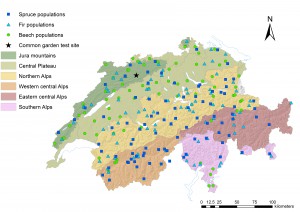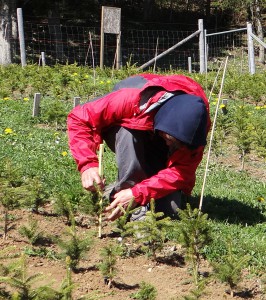In Switzerland, as well as in other European countries, Norway spruce and European beech trees are struggling to keep pace with the rapidly changing climate. This poses risks for the country’s forestry sector, which relies on spruce wood. A study by the Swiss Federal Institute for Forest, Snow and Landscape Research (WSL) shows that these risks could be mitigated by relying more on silver fir and using Norway spruce from warmer growth locations.
Climate change is making Swiss forests warmer and drier. The trees would have to adapt genetically to the rapidly changing climate to continue flourishing at their current growth location. Yet, they are unlikely to do so in such a short period of time – a single tree generation already takes 100 years or longer. Therefore, the question on how well adapted the trees already are today to the future climate will be crucial for the forests’ future.
Unique comparison of Norway spruce, silver fir and European beech

Graphic: WSL
A WSL research team led by Caroline Heiri, investigated for the first time the climate change induced risk faced by the three most important tree species for the Swiss forestry sector and timber industry: Norway spruce, silver fir and European beech. The researchers conducted their study within the framework of the research programme “Forests and Climate Change” run by the Federal Office for the Environment (FOEN) and WSL. First, they investigated how well the trees had adapted to the climate in their respective growth location over many tree generations. Strong genetic adaptation indicates that a tree population is dependent on certain environmental conditions, whereas little adjustment suggests an ability to thrive in various conditions. Based on climate scenarios, the research team then estimated the tree populations’ risk of being poorly adapted to the climates projected by the end of the 21st century.
The results certainly astonished. Previous studies had shown that especially Norway spruce on the Swiss Plateau will be under pressure from rising temperatures and dryer conditions. But the new study shows that this tree species is actually exposed to high climatic risk throughout Switzerland. Over past millennia, Norway spruce in Switzerland has evidently adapted very closely to the local climates at its growth locations. This will likely make them and their descendants increasingly poorly adapted to the rising temperatures expected for the coming decades, especially in regions that are already warm today.
The deciduous European beech is also exposed to climate risks, but less pronounced than Norway spruce. Contrastingly, silver fir was found to have hardly adapted its growth characteristics to local climates. Consequently, it seems likely that silver fir will cope well with ongoing climate change. “We were very surprised to find that Norway spruce showed indications for strong adaptation to local climates, whereas silver fir seemed to be barely adapted at all”, says Aline Frank of the WSL, the lead author of the study.
Need for action and hope for forestry
The new results, just published in Global Change Biology, are important for forestry practice. They show that Norway spruce, which was shown to be well adapted to the respective local climates and which is the bread-and-butter tree for the Swiss forestry sector, is endangered throughout the country by advancing climate change by the end of the 21st century.

Photo: Aline Frank / WSL
Thus, action needs to be taken if spruce-dominated forests are to be primed in good time for climate change. In future, Norway spruce should generally be used reluctantly, and only be promoted on sites featuring good water supply. To prepare for climate change, young Norway spruce grown from seeds originating from warmer habitats can be planted in places that are still cooler today – provided they are sufficiently frost-resistant to cope with potentially still harsher climatic conditions at their new location. The places of origin chosen can either be indigenous, e.g. Norway spruce taken from the valley floor to be planted in a forest at a higher altitude, or from particularly warm regions outside Switzerland.
A similar procedure could be applied for European beech, taking seeds from growth locations that are already dry today. “If we use seeds from trees in warmer and drier regions, we will at least have a chance for these species to thrive for yet another forest generation. This way, our forests will remain stable and protect us against natural hazards”, concludes co-author Caroline Heiri of the WSL from the research results. “However, there is no miracle provenance of Norway spruce or European beech”, says Aline Frank. “So, we must also consider the possibility of switching to other tree species”. Thus, silver fir, which the study showed to be an ‘all-rounder’ due to its low climatic fixation, may prove to be the forest practitioner’s big hope for the future. Accordingly, the promotion of this species offers major opportunities for the forestry sector.
Source
WSL, press release, 2017-08-10.
Supplier
Eidgenössische Forschungsanstalt für Wald, Schnee und Landschaft WSL
Schweizer Bundesamt für Umwelt (BAFU)
Share
Renewable Carbon News – Daily Newsletter
Subscribe to our daily email newsletter – the world's leading newsletter on renewable materials and chemicals










